Sasaki Partners with ILC to Pilot the Design Climate Survey
Reflections on our collective professional aspirations in the face of climate change
 Sasaki
Sasaki
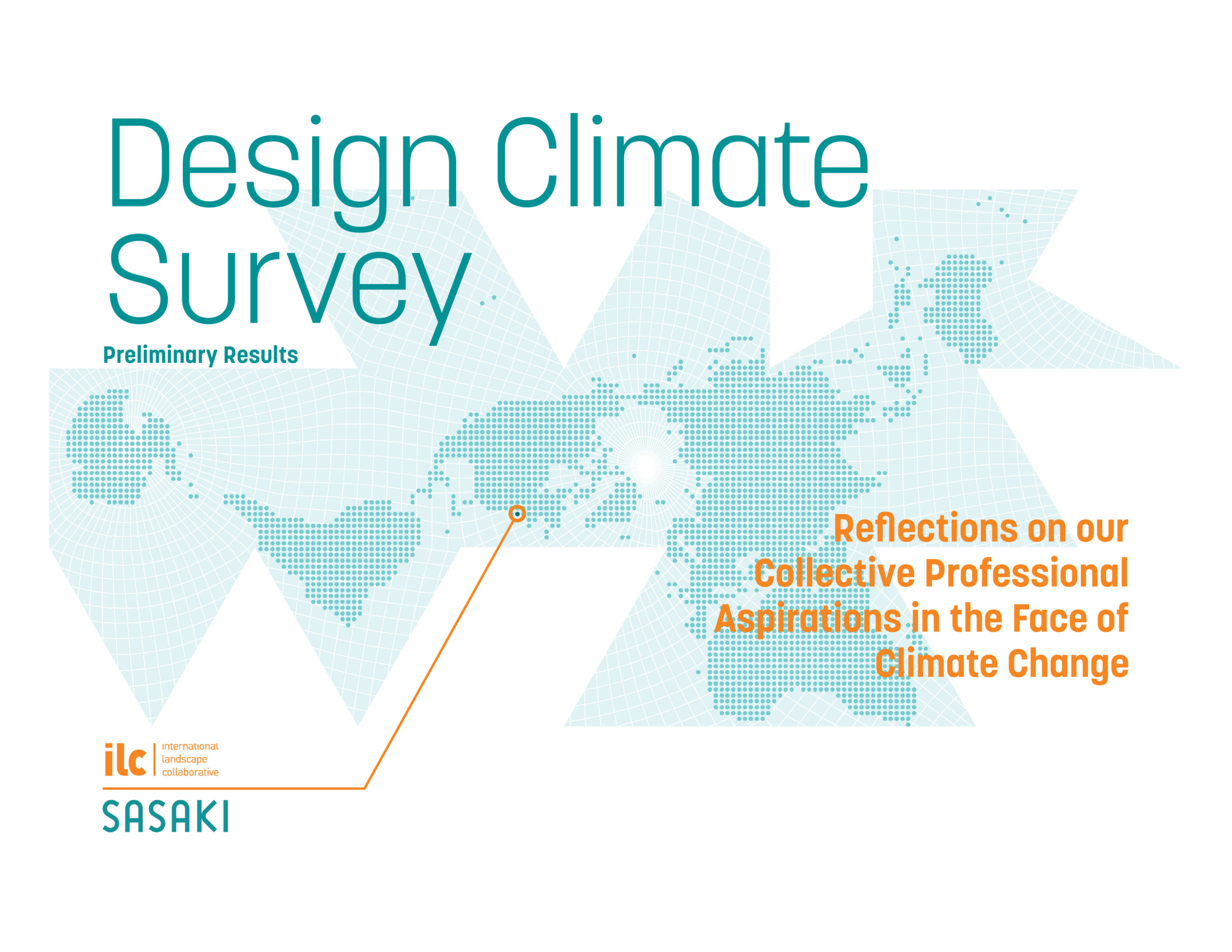
Written in collaboration with former Sasaki landscape architect Sourav Biswas and former Sasaki planner Justin Kollar.
At its core, the planning and design profession is optimistic. We are forward-looking and shape our built environment to anticipate a more just, sustainable, and resilient future. However, even as optimists, we have to come to terms with the reality that our planet is in the midst of an ecological crisis. Massive fires have engulfed communities in California, Siberia, and more recently Australia. Loss of arable land throughout the Middle East due to climate change has also played a role in instigating regional conflict and migration. Worsening environmental catastrophes such as when hurricane Harvey revealed the vulnerability of frontline communities in Houston, are likely to exacerbate in the face of climate change.
The term “Anthropocene” has recently entered the lexicon of many in the planning and design professions. Drawing from geological terminology, it describes our current epoch as one where human activity has pervasively and irreversibly altered the earth’s land, water, soil, and atmosphere. We respond to these challenges through our work on resilience and sustainability as a means to prepare human habitats to face increasingly harsh environmental hazards and shift our ways of building to reduce our carbon footprint. The politics of climate change have also reached our professional organizations. Recently, the ASLA and the AIA have endorsed the Green New Deal framework, the LAF inaugurated a New Landscape Declaration to promote action on climate change. The APA has taken positions on climate change by issuing a statement on the US withdrawal from the Paris agreement, and the ASCE released a list of policies addressing climate change.
Drawing from our collective interest in the discursive and material issues of the Anthropocene, the International Landscape Collaborative (ILC) and Sasaki have piloted the Design Climate Survey. The survey seeks to assess our disciplinary positions, professional realities, and collective aspirations towards addressing climate change in the Anthropocene. As a multi-disciplinary firm working across diverse contexts and scale, Sasaki represents a microcosm of the greater planning and design profession, and provides an ideal laboratory to prototype this survey. Preliminary results from the pilot survey have already revealed a few key questions for reflection and are elaborated upon in this blog post.
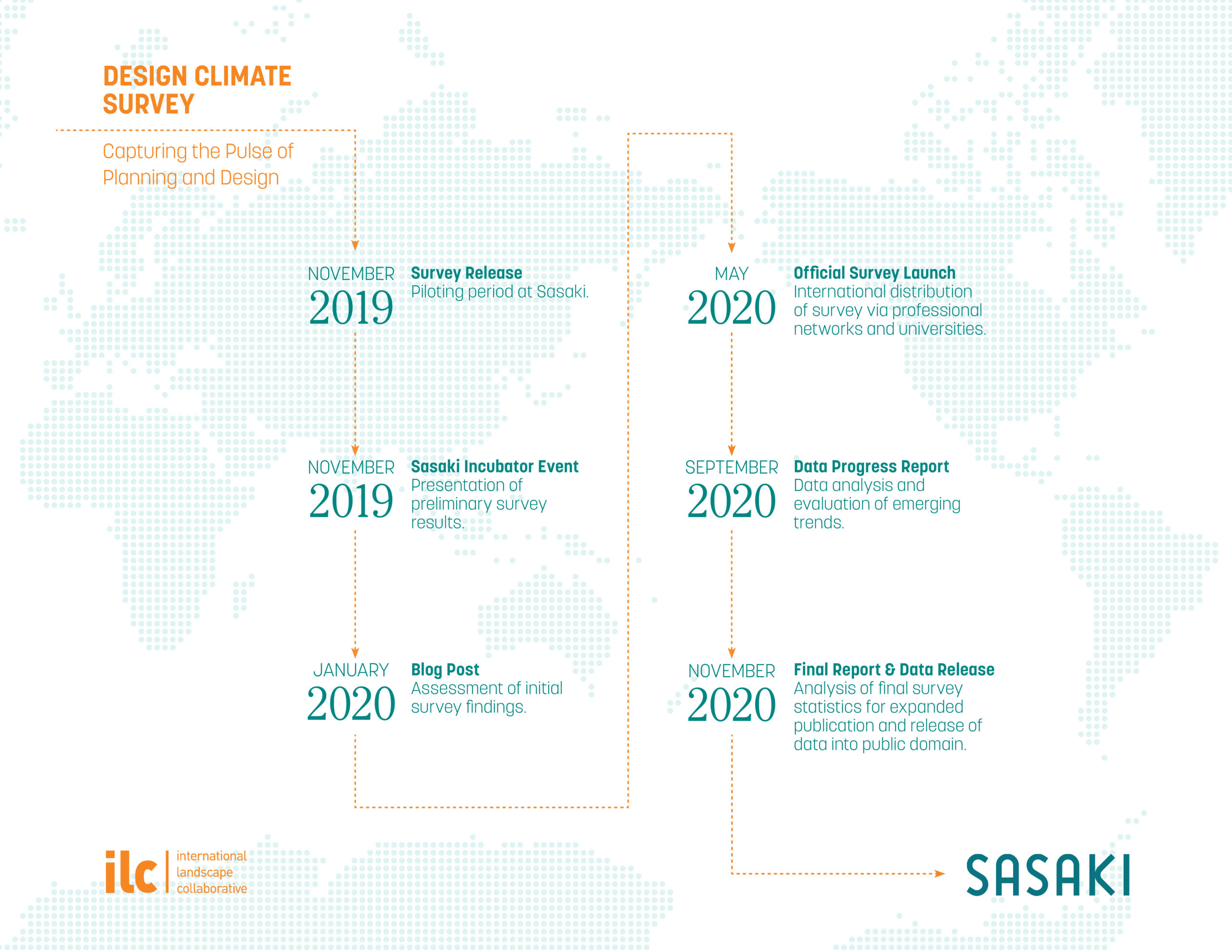
Ultimately, the Design Climate Survey seeks to understand how planning and design professionals across the U.S. and the world perceive our role in addressing the threats of climate change and building an environmentally just future. With responses from thousands of professionals from around the world, this survey will offer an informed foundation upon which we redefine our value proposition, explore new practice models, expand our engagement, and cultivate meaningful collaborations.
Please take the Design Climate Survey here!
As professionals, we largely work in cities: spaces with concentrated social and economic activity that are actively shaped by our built works, landscapes, and plans. Designers and planners have largely built their mandate by addressing the health impact of industrialization in our cities. But cities are sustained by “operational landscapes” that severely impact the health of the hinterland: expansive areas of agriculture, extraction, and logistics outside of the city proper, that have fundamentally transformed the planet in service of urbanization.
At Sasaki, respondents to the survey recognize that human activity impacts the atmosphere and oceans at a planetary scale, and that agriculture, fishing, forestry may be some of the most damaging human activities. Most respondents (80%) believe that the design and planning profession is best positioned to address issues of land and soil. However, urban areas comprise less than 1% of the planet’s habitable land. More than half the land is used for agriculture or forestry. Yet very few respondents (17%) have had the opportunity to address the impact of those sectors in their work. Designers and planners will continue to build upon their positive influence in urban development and construction. This role is significant since cities are disproportionately responsible for carbon emissions from our buildings and cars. But studies like Project Drawdown have ranked solutions related to land-use and agriculture as the most cost-effective ways to mitigate climate change.
The fight against climate change and mitigating human impact goes well beyond our cities and how we engage “land” at a planetary scale is worth collective reflection. Moving forward, we should think more critically about the extended landscapes beyond the city and how to collaborate with professionals and communities that are already active in protecting their lands from human impact and climate change.
To have a substantial impact in addressing climate change, planning and design professions must also build knowledge, cultivate agency, and advocate for our voice within the broader public discourse. Many of us may agree that our professions have an important role to play—echoed by the fact that most respondents (81%) at Sasaki strongly agree that their profession should play a leading role. However, when asked if they believe their practice currently plays a leading role in addressing climate change, the numbers start to shift. Most (44%) somewhat agree, and only some (17%) strongly agree with this statement. A significant number of respondents (38%) believe their profession should improve their leadership role. When asked if the general public sees their profession as playing a leading role to address climate change, the answers were more conservative. Only one third (36%) believe that the general public sees planning and design professions playing a leading role. These reflections may illustrate the professions’ strong identification as leaders on climate change, but points to a lingering perception that the general public may not fully comprehend the role of our work within the greater climate change discourse. In response to this, more than half (55%) expressed the need to advocate and promote our work more strongly to the general public.
Responses generally reflected the sentiment that we must collectively work to expand our knowledge and agency through engagement and reflection on the model of practice we pursue, so that we may advocate for greater public status of our work.
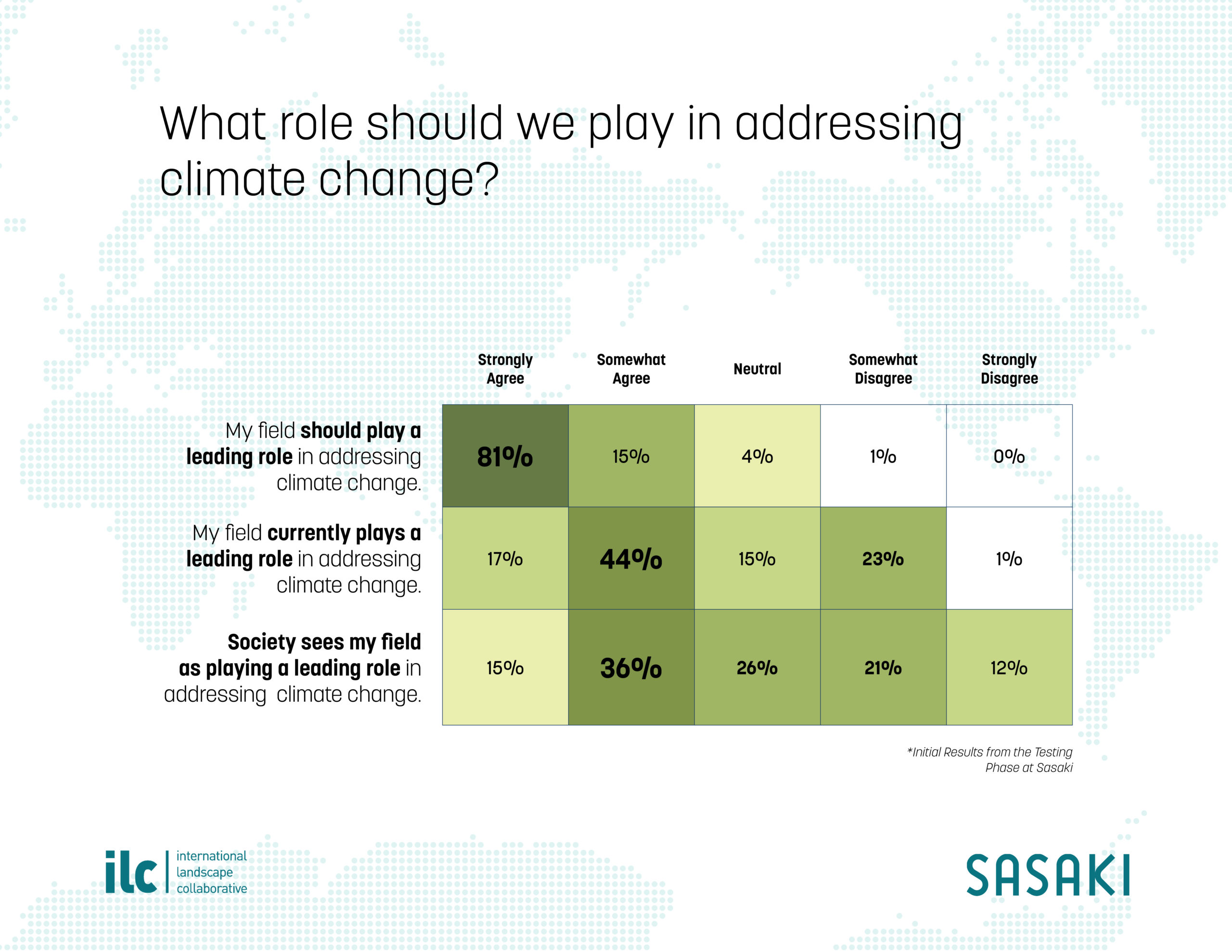
Outside of our professional practice, there is a larger, broader discourse centered around the impact of climate change. Media headlines on environmental crises such as water shortages, from Los Angeles, Cape Town, Chennai, and São Paulo, remind us of imminent environmental threats.
Other narratives elaborate issues of environmental degradation and disasters, sea level rise, displacement, migration, and resource crises. Respondents identified these phenomena as some of the most critical threats to address, but many have not had the opportunity to address in a professional capacity. Despite the apparent gap, two-thirds (61%) of respondents feel that their mission and work are aligned with their aspirations. However, there is a perception (among 88% of respondents) that limitations in our professional practice may prevent us from aspiring to address such critical issues. More than half of respondents feel that the scope of work in RFP’s and projects limit our capacities to address climate change meaningfully. Nearly two-thirds (60%) identified that the business model or scope of the field may also be a limiting factor.
Moving forward, we must strive to incorporate our professional aspirations by expanding our field through engagement with the client and by promoting collaboration with a wider range of professionals to increase our impact on climate change.
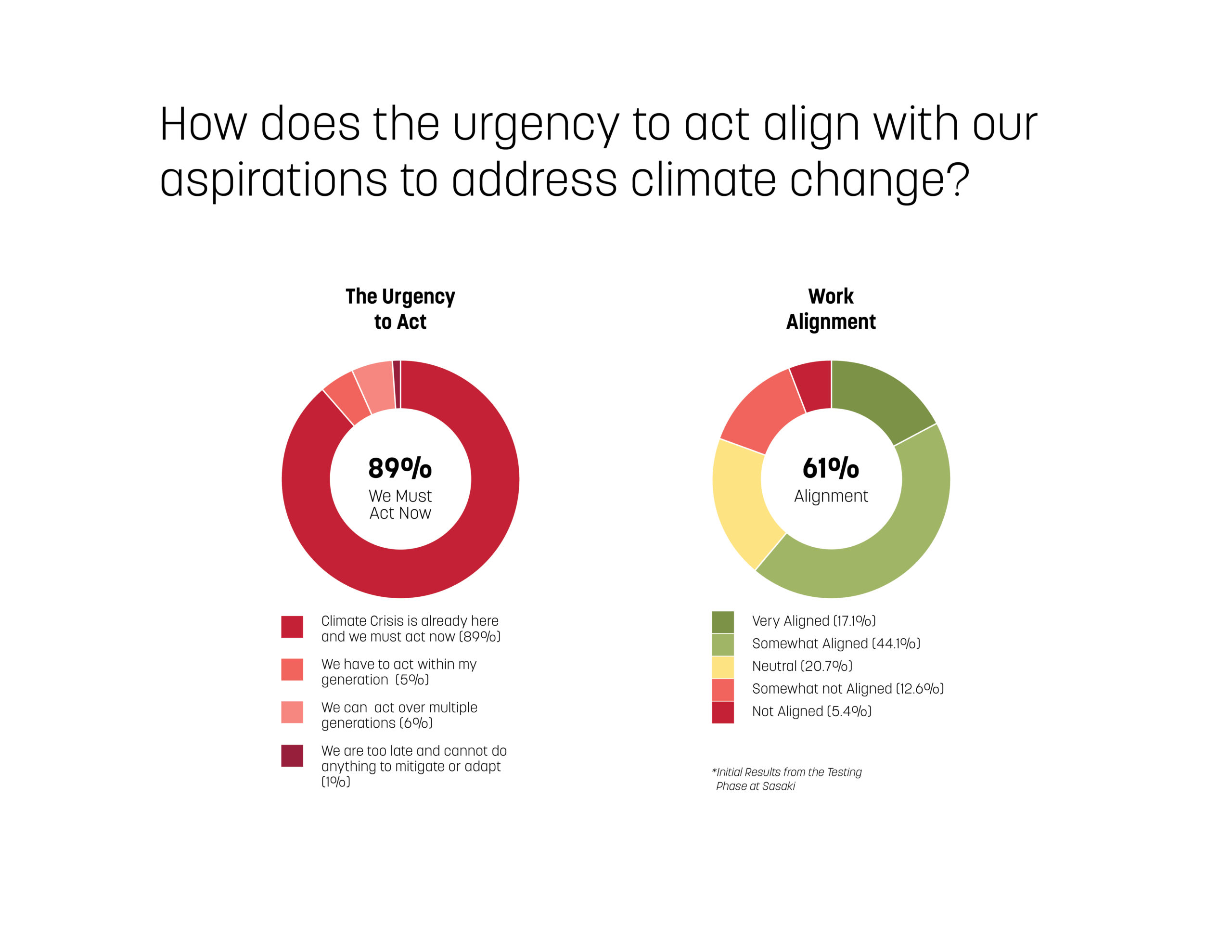
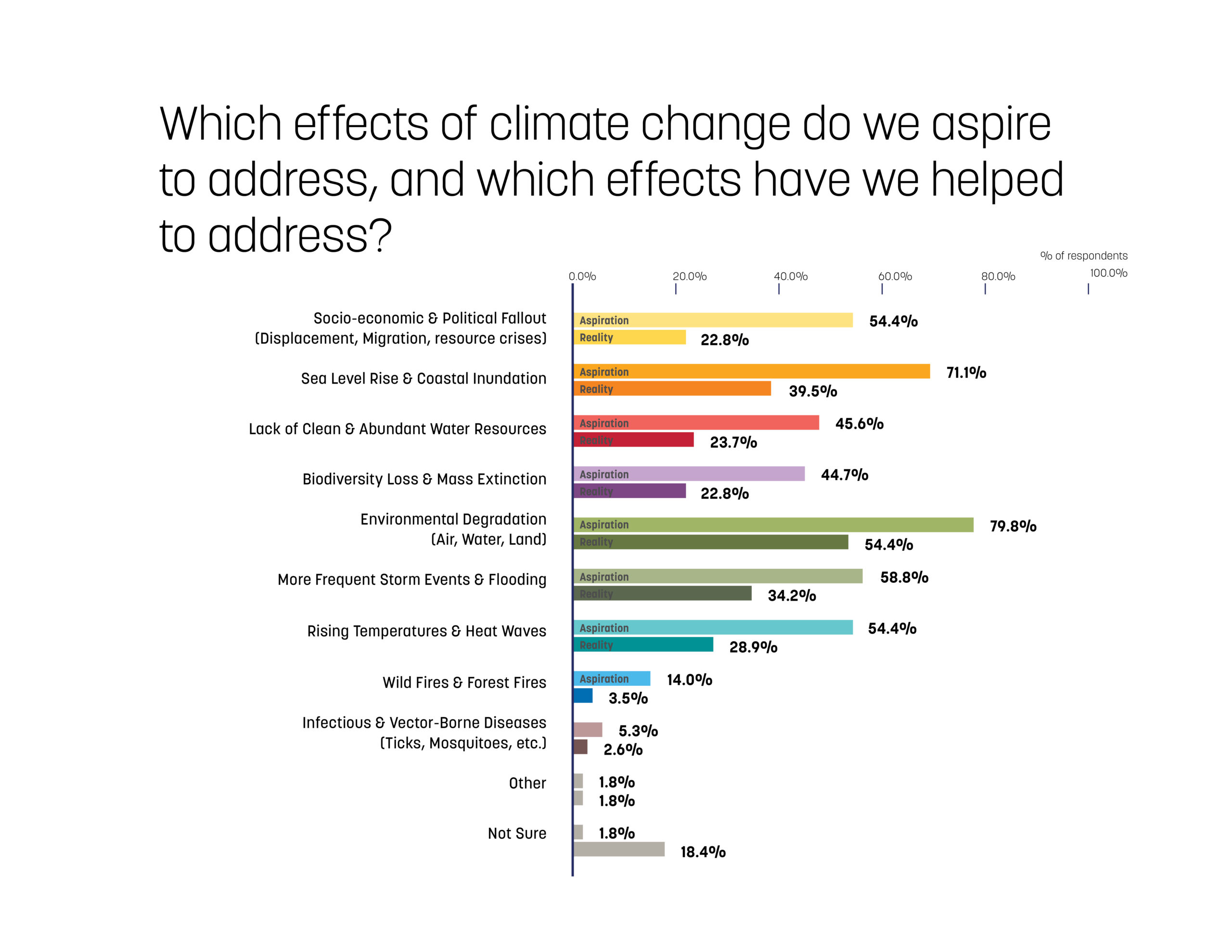
As noted above, the challenge that climate change poses is not only one of scale, but of scope. While encompassing the entire globe, the global climate is driven by a range of sectors which means that addressing its negative impacts will require earnest collaboration. One of the most needed areas of engagement is in policy-making. In examining our current work, we must ask: who should we be working with more to better understand and tackle the complexities of climate change? When asked how to address the limitations of our current models of practice, a range of possibilities were identified such as more cross-interdisciplinary collaboration (50%), expanding our professional knowledge base and technical capacities (44%), improving awareness of our profession to the general public (44%), improving client education and engagement while ensuring ethical client collaboration (70%), political advocacy and lobbying (40%), with some also identifying community engagement and local activism as a potential route to expand our professional reach.
It’s widely felt that to improve our impact, we must identify strategic collaborators—from science, engineering, humanities, and politics—to forge new coalitions that can open up alternative avenues of work with greater impact.
This survey is a reflective tool where the initial results begin to reveal key positions, aspirations, and realities of our professional work as it relates to climate change. The results within Sasaki—an interdisciplinary firm with architects, landscape architects, interior designers, urban designers, planners, and engineers—highlights our profession’s place within an interconnected network of actors that must all be involved in addressing the climate change issue.
Initial findings start to suggest a few common sentiments: as professionals engaged in addressing climate change, we must begin to look beyond the traditional scales and scopes, strengthen our leadership role through public engagement, realigning the scope of our work, and explore new models of practice and collaboration.
As more data is collected, we will have a stronger foundation from which to understand our collective professional aspirations, and begin to chart a way forward with conviction and common goals centered around saving our planet. By Fall 2020, the ILC will post the insights from the survey once we have collected more than a thousand responses.
We kindly ask you to take 5-10 minutes to voice your position on disciplinary and professional issues related to climate change (your participation in this survey is voluntary and all responses are anonymous).